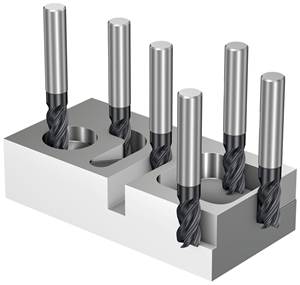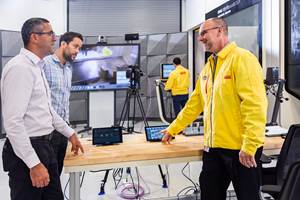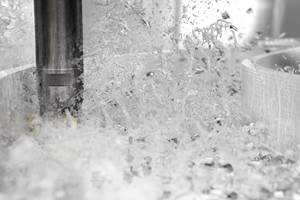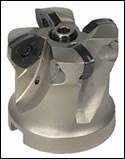Split Chip Technology Cuts Milling Days into Hours
High-feed indexable milling cutter with the new LC280TT grade insert proved to provide the productivity promised.
We've heard it all before: a new cutting tool promises earth-shattering productivity; the likes of which have never before been witnessed on this planet. By most accounts, these claims are exaggerated and result in disappointment when the tool is actually incorporated into the shop environment. But, then again, there are those tools that live up to, and even exceed what they promise.
Product Development Technologies, Inc. (PDT) (Lincolnshire, IL) is a global product development company with capabilities including design, tooling and manufacturing. In a quest for improved cycle times and cost savings, PDT's machining of mold bodies had previously gone from conventional indexable milling using APKT square shoulder style inserts to a high-feed style milling cutter using TiAlN coated inserts. Then, in August 2004, PDT tried the Twincut Vario high-feed indexable milling cutter with the new LC280TT grade insert from LMT-Fette (Cleveland, OH).
For PDT, however, the Vario's capabilities were not immediately recognized. A sample cutter sat on Vito Sarullo's, PDT programming engineer/manager, desk for a month before it was tested. Persistence on the part of the LMT-Fette's sales engineer, Martin Hazelhorst and Glen Korff, sales manager, Zenger's Industrial Supply—a distributor of LMT-Fette products—convinced Sarullo to try the Vario by promising reduced machining time. "When people use the Vario, their existing cutters can't compete—hands down," says Hazelhorst.
The results were astounding. The machine cost of milling dropped from 12¢ per cubic inch to 6¢ per cubic inch. Tooling costs dropped from 31¢ per cubic inch to 2¢ per cubic inch. The total cost for the operation went from 42¢ per cubic inch to 8¢ per cubic inch. The result is a savings of 81.6 percent from the Vario. "Our operation went from about 17 hours down to only five hours," says Sarullo.
PDT now uses the Vario with its patented split chip technology to rough molds for automotive exhaust manifolds. The tool used to machine this 36" x 28" x 5", #4140, 30 RcC mold base has a seven-inch overhang and is being done in a Makino MCB 1210, horizontal 50 taper with 25hp.
Before discovering the benefits of the Vario, PDT tried a competitor's cutter to mill its mold bases. "Using the Vario we went from 20 inserts to only five inserts per base," explains Sarullo. "I could go to my boss with the savings on inserts alone." Hazelhorst outlines the advantages of the Vario LC280TT grade insert when compared to most competitors' inserts, "A more expensive insert milling 500 cubic inches of steel could only run a half hour, it would fail due to heat, lose accuracy due to wear on its radii, and tear into the cutter body." The Vario's inserts can run one hour and 40 minutes per edge. Multiply that times eight edges and you realize a huge savings.
PDT uses a 2.73" diameter Vario at cutting speeds of 457 sfm and 640 rpm with a feedrate of 123 ipm and 0.120" doc. This contrasts with PDT's former cutting tool of two-inch diameter that operated at 400 sfm and 764 rpm with a feedrate of 30.64 ipm and 0.200" DOC. The Vario's patented split chip technology and unique 23-degree positive rake geometry, allows it to perform at 50 percent of the spindle load in this application—reducing wear and tear on the machine.
Designed for roughing, the Vario uses exclusive split chip technology to achieve high feedrates. "This is the perfect application for the Vario and it's a quantum leap from where PDT started to where they are now," says Korff. PDT experienced drastic processing time reductions—from 17 hours to five hours when roughing a mold base pocket with the Vario.
Vario Design
The Twincut Vario's split chip technology offers a patented geometry where two axially and radially offset cutting edges combine to make the cut. The upper and lower rows of cutting edges each have different angles of approach and cutting depths. This produces a technically superior chip cross-section with a four times smaller width to height relationship. As a result, required cutting forces can be reduced.
The unique design of the cutter body combined with the grade and the positive and negative rakes of the eight-sided insert all contribute to the performance of the Vario. "The inserts don't chip; they just don't break," continues Sarullo. "And when they re-cut chips, they don't crack." The durability of the LC280TT grade enables it to freely mill around chips that have collected in a pocket; it just cuts around a pocket one-third full of chips," states Sarullo. "This is a 0.120" depth-of-cut. Normally you would have to blow the chips out. Safety is not an issue here either."
Aggressive machining such as that performed at PDT typically warrants strict monitoring of the spindle by an operator. In the case of the Vario however, reduced risk of insert failure results in greater peace of mind and use of time. "You can actually walk away for a time and not have to worry about the insert tearing up the base or cutter body," notes Hazelhorst.
LMT-Fette's Vario also overcomes what was once considered a given—excessive noise and vibration. "Our shop shares a wall with our CMM department. Reduced interference is important when using accurate measuring devices," says Sarullo. The Vario's split chip technology results in quiet operation and minimal vibration, even in unstable machining conditions.
Another LMT-Fette Vario benefit that contributes to reduced machining time is no additional programming is needed for the Vario after initial settings have been entered. "We're cutting steel that is unpredictable, but we can use the exact same program with the Vario Cutter instead of having to change the cutting parameters to make up for inconsistencies," adds Sarullo. "The fact that we don't have to concern ourselves with the variations in the steel or the overhang of the tool are huge factors above and beyond the milling itself."
LMT-Fette's Twincut Vario proved to provide the productivity promised by the salesperson and more. It yielded dramatic improvements in reduced machining time, lower cost for tooling, longer tool life, reduced vibration and noise, provides operators the ability to walk away from the machine, reduced programming time, less wear and tear on the machine and improved safety yielding great peace of mind. It's not that often that you get the satisfaction of finding something that is better than promised.
Related Content
How to Machine Aluminum Molds to Enhance Efficiency and Quality
Ways to optimize the machining process to fully leverage the benefits of an aluminum mold.
Read MoreHow to Use Continuing Education to Remain Competitive in Moldmaking
Continued training helps moldmakers make tooling decisions and properly use the latest cutting tool to efficiently machine high-quality molds.
Read MorePrecision Meets Innovation at IMTS 2024
After attending IMTS, it's clear that the integration of advanced technologies is ready to enhance precision, efficiency and automation in mold manufacturing processes. It’s a massive event, so here’s a glimpse of what the MMT team experienced firsthand.
Read MoreHow to Overcome Cutting Tool Vibration
Advanced indexable milling cutting tool design provides secure, predictable machining, increased metal removal rates, reduced cycle times and fast changeovers.
Read MoreRead Next
Match Cutting Tools To Machine for Maximum Efficiency
A large range of tooling enables moldmakers to match cutting tool to machine and part geometry, resulting in maximum metal removal rates and productivity for roughing applications on conventional and high-speed machining centers.
Read MoreOvercoming Pain Points in Moldmaking with AI
Shops that embrace AI as a tool, not a threat, can enhance efficiency, preserve expertise, and attract tech-savvy talent.
Read MoreHow to Use Strategic Planning Tools, Data to Manage the Human Side of Business
Q&A with Marion Wells, MMT EAB member and founder of Human Asset Management.
Read More



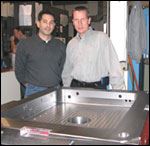
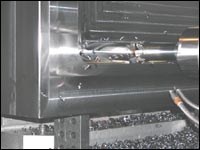










 (4).png;maxWidth=300;quality=90)








